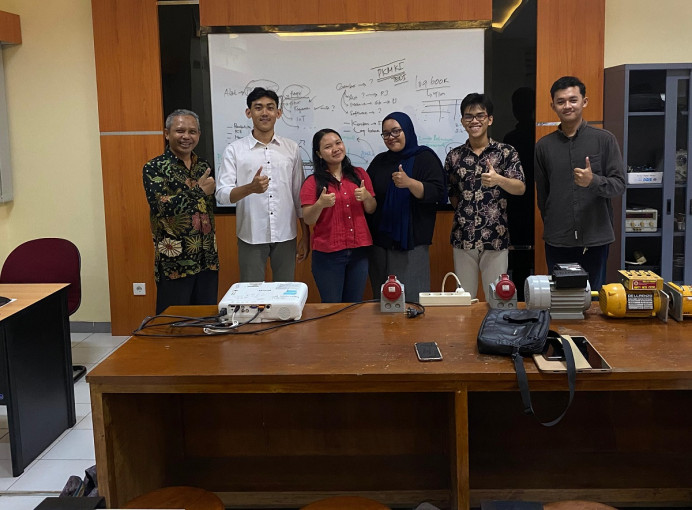
A team of five UGM students has created an innovative therapeutic device called ARTERI. This device, integrated with a mobile app, monitors oxygen saturation and blood pressure levels to assess therapy effectiveness.
UGM students created the ARTERI device due to the problems arising from the current conditions where monitoring oxygen saturation and blood pressure in stroke patients is limited to specialized medical equipment that is often only available in healthcare facilities.
Angelia Grace, a UGM Biomedical Engineering student, explained that the device’s development started from concerns for stroke patients, including limited time, the need for accompaniment from physiotherapists, the limited availability of physiotherapists who are sometimes unavailable or suddenly change schedules, and the high cost of physiotherapy.
Meanwhile, stroke therapy evaluation has generally been highly dependent on subjective observation and visual examination by therapists. Given this, she believes there is a need for a more objective and measurable evaluation method to identify patient progress and determine therapy effectiveness more accurately, equipped with real-time therapy data to assist medical personnel and patients.
“Therefore, the five of us sought to find a solution by creating a stroke therapy device integrated with a mobile application to address these issues,” said Grace at the UGM campus on Monday (Jul. 15).
In addition to Grace, the other four UGM students who helped create this device are Bayu Ari Wandyka, Ferhad Zulfas (Instrumentation and Control Engineering Technology), Novy Pratama Andriani (Heavy Equipment Management and Maintenance Engineering), and Ganang Fattahuddien Attar (Medicine).
They received guidance and mentorship from Maun Budiyanto and funding support from the Ministry of Education through the Student Creativity Program in Intellectual Creation (PKM-KC).
Ganang Fattahuddien Attar stated that his team chose to monitor oxygen saturation and blood pressure because oxygen saturation represents the adequacy of oxygen in the body to determine appropriate therapy, while blood pressure triggers blood vessel rupture in the brain. This is similar to stroke, which involves blockage and rupture of blood vessels in the brain.
“The relationship between blood pressure and oxygen saturation with stroke is that reduced oxygen supply to stroke-affected tissues, especially in ischemic stroke, can cause hypoxia. A person with a stroke will have their breathing evaluated because of the risk of hypoxia, which can affect brain cells,” said Attar.
Therefore, oxygen saturation must be controlled because it is closely related to the oxygen supply necessary for brain survival. Meanwhile, blood pressure greatly influences the occurrence of hemorrhagic stroke. Prolonged hypertension also causes disturbances in the elasticity of the small arterial walls, leading to rupture.
“Therefore, maintaining blood pressure in stroke patients is very important to prevent ongoing brain damage,” Attar said.
Ferhad Zulfas added that the process of creating this therapeutic device uses materials such as NodeMCU ESP32, MAX30100 sensor, MPX 2050 sensor, servo, switch, Li-Po battery, battery casing, port cable, jumper cable, AWG 24 cable, fuse, acrylic, aluminum plate, glue, LED lights, flex sensor, DC converter, PLA+ filament, and medical velcro.
Bayu Ari Wandyka explained that the device works when the therapy command is activated through the ARTERI application, which is integrated with IoT. The servo will move up and down according to the four-level settings in the application, based on a 30–40-degree angle.
It uses several sensors to read oxygen saturation and blood pressure in patients, which utilize the sensor’s conductivity and will be converted into ppm units.
Once the oxygen saturation, heart rate, and blood pressure readings are obtained, they are sent to the cloud server for access using a laptop or smartphone. The ARTERI application has several features, including test results, progress graphs, tutorial videos, medical records, and settings.
“Thus, ARTERI is expected to help the community monitor and improve stroke therapy effectiveness, enabling more personalized and adaptive care based on individual patient responses and early prevention or handling of conditions to prevent complications arising from lack of oxygen or high blood pressure,” said Wandyka.
Prioritizing health procedures, Novy Pratama Andriani stated that this innovation is expected to be a tangible contribution and support the Sustainable Development Goals (SDGs), a concept agreed upon by world leaders, especially point 3 (good health and well-being).
The ARTERI device is also expected to encourage the use of photoacoustics for further technological advancements in the health sector.
Author: Novy Pratama Andriani
Editor: Agung Nugroho
Photo: Arteri Team Documentation

